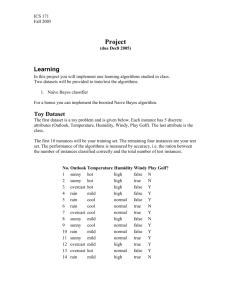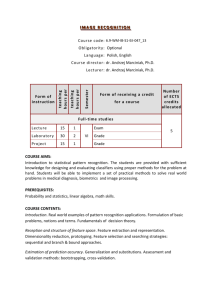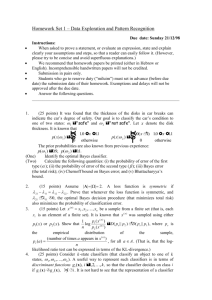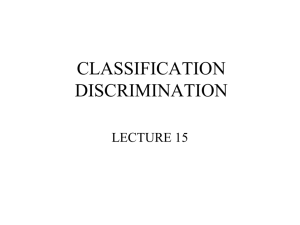Mini-project assignment MS1b Statistical Data Mining Deadline Mini
advertisement
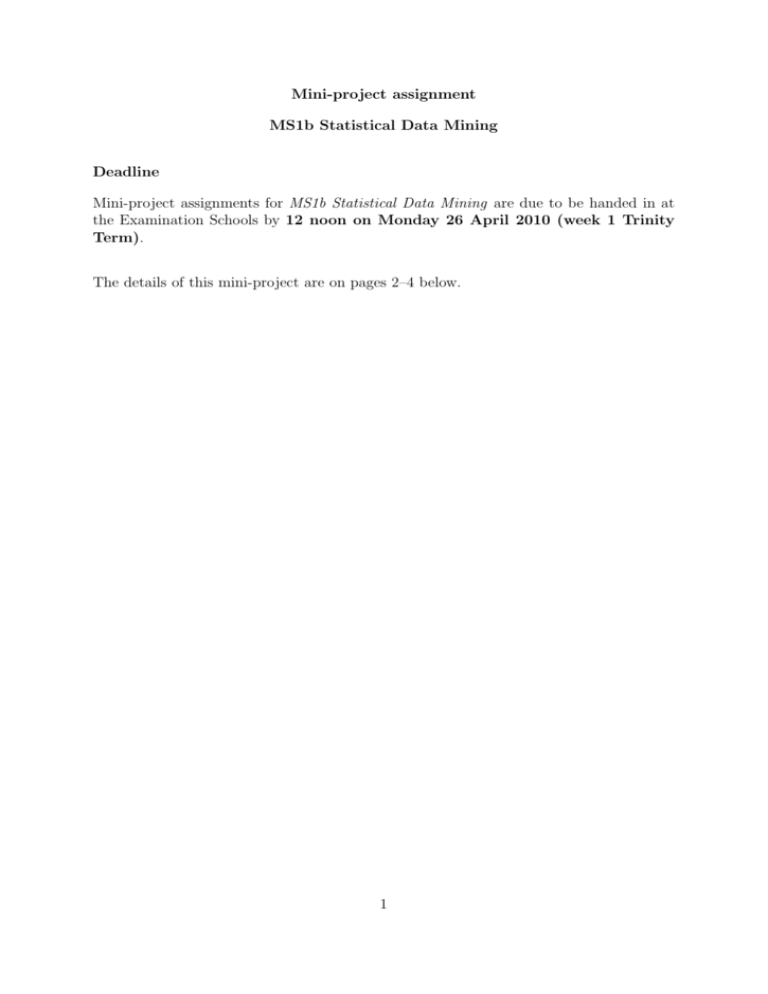
Mini-project assignment
MS1b Statistical Data Mining
Deadline
Mini-project assignments for MS1b Statistical Data Mining are due to be handed in at
the Examination Schools by 12 noon on Monday 26 April 2010 (week 1 Trinity
Term).
The details of this mini-project are on pages 2–4 below.
1
Mini-project MS1b Statistical Data Mining, HT 2010
Gene expression data
The 6 relevant datasets for this mini-project contain gene expression data along with
tumour class information from a certain number of patients1 . For each patient one knows
the response variable, which is binary (in {0, 1}), where 1 indicates presence of a specific
tumour (or subtype of one) and 0 absence of this tumour. Also available are for each
patient several thousand predictor variables, namely the gene expression pattern for this
patient on several thousand measured genes. Using the available samples, it is of interest
to build a classifier that can provide a good classification of absence/presence of tumours
for new patients.
You can download the predictor variables for each of the 6 datasets (in X1.txt,. . . ,X6.txt)
from the website
http://www.stats.ox.ac.uk/~meinshau/MS1/miniproject
The associated outcomes are in the files Y1.txt,. . . , Y6.txt on the same site.
You should produce a report that covers the six tasks below.
Take extra care to ensure that your report is clear on how you have performed the
analysis, so that an interested reader could reproduce your results. For example, if a classifier needs a choice of tuning parameters, describe how you set these tuning parameters,
whether you used cross-validation (and which form of cross-validation, if so), and so on.
The report should not contain computer code. You may (and are encouraged to) include
figures.
Task 1: Bayes Classifier Describe the Bayes classifier for general two-class problems
(without using the data yet). Why do we not have access to the Bayes classifier in
practice? Describe plug-in classification and give an example for plug-in classification
(again, without using the data yet).
10 marks
Task 2: Dimensionality Reduction Reduce the dimensionality of the data from p
to p̃ = 2 by Principal Component Analysis or metric Multi-Dimensional Scaling and plot
the training samples in the resulting two-dimensional plane for gene-expression datasets
2 and 5. Indicate the class of each sample by plotting symbols and/or colour (you
should not use this class information in the dimension reduction itself). Based on this
2-dimensional projection, for which of the two datasets would you expect to achieve a
better classification (in the sense of lower misclassification error)?
1
the patients are not identical across datasets
2
What is the minimum number of dimensions needed to preserve 90%, 95% and 99%
of the variability in the data for each of the six datasets?
15 marks
Task 3: Clustering For each of the six datasets, perform a k-means clustering of the
data with k = 2 clusters, without using the class labels.
What would the misclassification error rate be (on each given dataset) if you classified
observations in one cluster as class 0 and observations in the second cluster as class 1?
If you obtain misclassification errors larger than 50%, you should switch the labels. How
accurate could you be with simple random guessing of class membership on average in
comparison?
15 marks
Task 4: LDA analysis Use Linear Discriminant Analysis on the 5th dataset (X5.txt
and response Y5.txt).
Include the first k genes in the list in the same order as they appear in the matrix
X5.txt. Based on these k genes, compute the LDA prediction on the data and compute
the error rate. For the LDA prediction, use 10-fold cross-validation.
Plot the cross-validated error rate (the misclassification error based on the crossvalidated predictions) while varying the number of genes between k = 2, 3, 4, 5, . . . , 50
(always taking the first k, using the same order as in the data files). How many genes
should be included in the LDA analysis? Why do you think the performance possibly
deteriorates for very large values of k?
15 marks
Task 5: Classifier comparison Fit single trees and Random Forests to all datasets
and explore their classification performance. In each dataset, use only the first 200 genes.
Try to use 5-fold cross-validation, if possible, to estimate error rates. Produce Receiveroperating characteristic (ROC) curves for each classifier and interpret the results. Which
of the two methods would you prefer if you wanted to get the most accurate predictions
on these datasets (again using only the first 200 genes)?
How many of class 0 observations are misclassified with either method in all datasets,
when at most 1/3 of all class 1 are misclassified?
Using either method for the 5th dataset, find some genes which seem to be important
for a good classification.
25 marks
Task 6: Naive Bayes and nearest neighbour classification In LDA, the p × pcovariance matrix Σ̂ of the p predictor variables/genes is estimated from the data by
maximum likelihood estimation. For ‘Naive Bayes’, only the diagonal terms of the covariance matrix are kept and all non-diagonal terms are set to 0. Find a simple description
of the ‘Naive Bayes’ classification rule (assuming that each variable is standardized to
mean 0 and variance 1) under the assumption that prior probabilities are equal for each
class. Compare briefly with a nearest neighbour classification method under Euclidean
distance, giving a possible computational advantage of ‘Naive Bayes’. What is a possible
3
advantage of Naive Bayes in higher dimensions compared to LDA? Compute the Naive
Bayes solution for the 5th dataset when including the first k = 2, 3, . . . , 100 genes and
compare with the LDA result you obtained in Task 4.
20 marks
[End of mini-project assignment]
4


